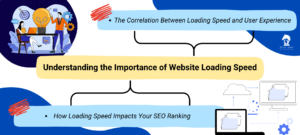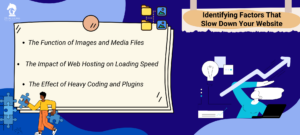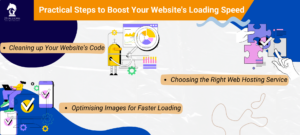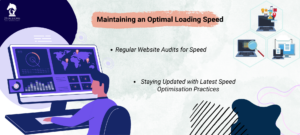Content
SHARE

In today’s fast-paced digital world, website loading speed plays a crucial role in determining the success of your online presence. Slow-loading websites can be frustrating for users, leading to higher bounce rates and decreased conversions. Moreover, search engines like Google prioritise websites that load quickly, boosting their visibility in search results. Therefore, it is essential for website owners to understand the importance of optimising loading speed and take proactive steps to ensure a smooth user experience.

Understanding the Importance of Website Loading Speed
When it comes to websites, the adage “time is money” couldn’t be more accurate. Research has shown that users expect websites to load within a matter of seconds. If a website takes too long to load, users are likely to abandon it and seek alternatives. This has a direct impact on conversion rates, sales, and overall user satisfaction.
The Correlation Between Loading Speed and User Experience
A slow-loading website can be a major turnoff for users. It creates a poor user experience, making visitors frustrated and perceive your website as unreliable or outdated. As users expect instant access to information, a slow website can make them feel as if they are wasting precious time waiting for content to appear.
Furthermore, studies have shown that slow-loading websites tend to have higher bounce rates due to users leaving the site without exploring further. This not only affects the immediate user experience but also has long-term consequences for your website’s traffic and engagement metrics.
Imagine this scenario: a potential customer is searching for a product or service that your website offers. They come across your website in the search results and click on the link, excited to find what they need. However, if your website takes ages to load, their excitement quickly turns into frustration. They might even decide to abandon your website and look for alternatives. This not only results in a lost opportunity for conversion but also tarnishes your brand image in the eyes of that potential customer.
On the other hand, a fast-loading website creates a positive user experience. It shows that you value your visitors’ time and have invested in providing them with a seamless browsing experience. This can lead to increased trust, engagement, and ultimately, conversions.
How Loading Speed Impacts Your SEO Ranking
In addition to user experience, website loading speed plays a significant role in your website’s search engine optimization (SEO) ranking. Search engines such as Google consider loading speed as one of the factors when determining the quality and relevance of a website. The quicker the website loads the higher it ranks in the search results, giving them a competitive edge over slower-loading competitors.
Furthermore, Google has explicitly stated that page speed is a ranking factor for mobile search results. With the proliferation of mobile devices, ensuring your website loads quickly on the devices has become more critical in maintaining a high SEO ranking.
Think about it: Often on the go or with limited time, users go on their mobile devices to search for information. Potential customers are likely to abandon and move to a faster-loading competitor if your website takes too long to load on their mobile device. Not only are you losing customers but your website’s visibility in search results may also suffer.
User experience can be improved by prioritising website loading speed, which also strengthens your chances of ranking higher in search results leading to more organic traffic, increased visibility, conversions opportunities and business growth.
Identifying Factors That Slow Down Your Website
Several factors can contribute to a sluggish website. Identifying these factors is the first step towards improving loading speed and enhancing user experience.
The physical location of your web hosting server can affect loading speed, especially for users accessing your site from different parts of the world.
Solution: Choose a server location closer to your target audience can reduce latency and improve loading times, providing a smoother browsing experience.
The Function of Images and Media Files
Rich media content such as images, videos, and audio files can significantly impact loading speed. Large file sizes, improper compression, and an excessive number of media files can slow down your website. Implementing lazy loading techniques for media content improves initial loading times by deferring the loading of off-screen images and videos.
The Impact of Web Hosting on Loading Speed
Your choice of web hosting provider can influence the loading speed of your website. Shared hosting, where multiple websites share resources on the same server, may result in slower loading times due to increased traffic and limited resources. Consider upgrading to a dedicated or virtual private server (VPS) hosting, which offers greater speed and reliability.
The Effect of Heavy Coding and Plugins
Excessive coding or reliance on numerous plugins can also slow your website’s loading speed. Websites with complex code structures or excessive plugins require more server resources, resulting in slower loading times. Streamlining your website’s code and minimising the use of unnecessary plugins improves the loading speed.
Moreover, minification practice, which involves removing unnecessary characters, and white spaces from code, helps to reduce file sizes and improve loading speed. Website owners can enhance performance and deliver a seamless user experience, by implementing efficient coding practices, and regularly auditing plugins for necessity.
Practical Steps to Boost Your Website’s Loading Speed
Let’s explore some practical steps you can take to enhance loading speed and provide a seamless user experience.
When it comes to improving your website’s loading speed, attention to detail is key. By implementing a combination of strategic techniques, you can significantly enhance your site’s overall performance and keep visitors engaged.
Optimising images is a fundamental aspect of improving loading speed. By carefully resizing and compressing images, you can strike a balance between visual appeal and efficient loading times. Consider utilising responsive images that adapt to different screen sizes, ensuring a smooth browsing experience across various devices.
Optimising Images for Faster Loading
One of the most effective ways to improve loading speed is by optimising images. Resize and compress images without compromising quality, and consider using responsive images that adjust based on the user’s device. Additionally, leverage modern image formats such as WebP, which offer better compression and faster loading times.
Choosing the Right Web Hosting Service
Choosing the right web hosting service is crucial for ensuring optimal loading speed and site performance. A reliable hosting provider can significantly change how quickly your website loads for visitors. Look for a hosting service that offers robust performance, minimal downtime, and scalable bandwidth to accommodate your site’s needs.
Ensure that your website is hosted on a reliable and fast server. Research different hosting providers, and choose one that offers excellent performance, minimal downtime, and sufficient bandwidth for your website’s needs. Investing in a high-quality hosting service is an investment in your website’s loading speed and overall success.
Cleaning up Your Website’s Code
Review your website’s code and eliminate any unnecessary or redundant elements. Minify your CSS and JavaScript files to reduce file sizes and improve loading speed. Additionally, remove outdated or unused code that may slow down your website’s performance.
Monitoring Your Website’s Loading Speed
Improving loading speed is an ongoing process. Regularly monitor your website’s loading speed to identify any new issues or areas of improvement. There are various tools available that can help you measure and analyse your website’s performance.
Tools for Measuring Website Speed
Utilise tools such as Google PageSpeed Insights, Pingdom, or GTmetrix to assess your website’s loading speed and receive actionable recommendations for improvement. These tools provide valuable insights into factors that may be slowing down your website and offer specific suggestions to address them.
Interpreting Speed Test Results
When analysing speed test results, pay attention to metrics such as :
- Time to first byte (TTFB)
- Total page size
- The number of server requests.
These metrics can help you identify potential bottlenecks and prioritise areas needing improvement. Aim for faster TTFB, smaller page sizes, and fewer requests to optimise your website’s loading speed.
Maintaining an Optimal Loading Speed
Improving your website’s loading speed is a task that takes time to get started. To ensure optimal performance, it is essential to continuously monitor and maintain loading speed.
Regular Website Audits for Speed
Perform regular audits of your website to identify any new issues that may affect loading speed. Keep an eye out for large media files, outdated code, or plugins that may be slowing down your website. Regular maintenance will help you address speed-related issues promptly and keep your website running smoothly.
Staying Updated with Latest Speed Optimisation Practices
Stay informed about the latest speed optimisation techniques and best practices. The digital landscape is constantly evolving, and new technologies, tools, and strategies emerge regularly. By staying up to date, you can ensure that your website remains competitive in terms of loading speed and user experience.
In conclusion, improving your website’s loading speed is a fundamental step towards enhancing user experience, increasing conversions, and enhancing your website’s visibility in search engine rankings. To ensure a fast and user-friendly website that provides excellent engagement, one must understand the importance of loading speed, identify factors that slow down your website, and implement practical steps to optimise speed.
Website Speed Optimisation FAQs
Why is website loading speed important?
Website loading speed is crucial because it directly impacts user experience, search engine rankings, and conversion rates. Faster websites provide a better user experience, are favoured by search engines like Google, and typically see higher engagement and conversion levels.
What are some effective ways to improve website loading speed?
Effective ways to enhance loading speed include optimising image sizes, minimising HTTP requests, using content delivery networks (CDNs), enabling browser caching, and reducing server response time.
How can reducing file sizes impact loading speed?
Reducing file sizes, particularly for images, videos, and scripts, can significantly decrease the amount of data that needs to be loaded. This reduces the time it takes for pages to load, improving overall site performance and user satisfaction.
What tools can be used to assess and improve website loading speed?
Tools like Google PageSpeed Insights, GTmetrix, and WebPageTest offer comprehensive assessments of a website’s performance, providing specific recommendations for improvements to increase loading speed.
















